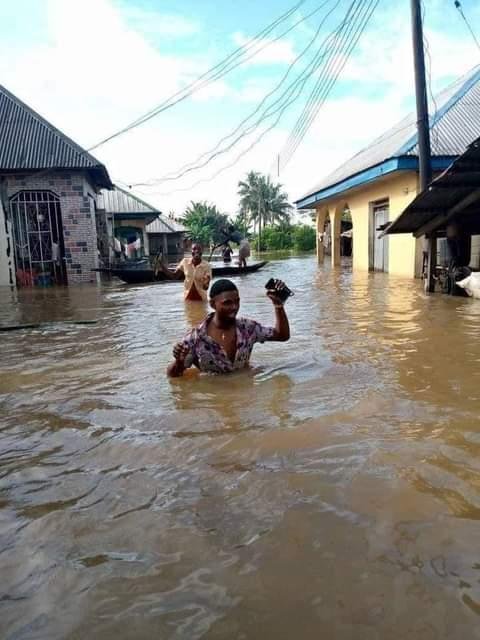Every year, residents and communities situated in flood-prone areas become apprehensive during the onset of the rainy season.
The reason is not far-fetched, flood leads to the destruction of properties, farmlands, and even death.
In the year 2012, records had it that, flood-displaced two million Nigerians from their homes and three hundred and sixty-three people lost their lives to flood.
By 2016, there was a reduction in the havoc recorded, as ninety-two thousand people were displaced while thirty-eight people died, and by 2017, floods affected two hundred and fifty thousand people.
Last year, Nigeria witnessed its worst flood in years with survivors desperately crying for help.
This is not because it caught the country unawares, experts warned in 2012 that there will be a return period of peak flood which is in the year 2022, but the huge havoc witnessed during this year’s flood points to the fact that little or no preparation was made.
Flood is a global phenomenon that can affect a few houses and communities in flood-prone areas, year 2022 flood in Africa’s most populous country came with severe implications that called for drastic action.
The country witnessed water overflowing its banks as predicted by NIMET, and properties were lost.
One of the victims, was a middle-aged man, Damilola Faleye who borrowed a motorcycle from his brother in a bid to beat traffic and get to work early after the torrential downpour of the previous day.
Unfortunately, he missed his steps while trying to navigate his way in a flooded area, but he was not so lucky as the flood swept away the motorcycle, and his life was saved through the speedy intervention of the people nearby that pulled him out of the water.
Faleti who could not control the tears while speaking with newsmen narrated how his brother got the motorcycle through a higher purchase and has not completed payment before the unfortunate incident.
In another community, over fifteen houses were taken over by flood as the bridge caved in and water overflowed its bank and over the community with residents crying for help.
Little did they realize that the September rain will be deadlier and what they witnessed in June was the tip of the iceberg.
By September 2022, the report says, over five hundred people have died with close to ten thousand houses destroyed.
States like Kogi, Bayelsa, Anambra, Gombe, and Lagos were worst hit as victims share experiences of how they lost properties and entire livelihoods, and in some cases, communities were totally submerged.
Although, The Nigerian Meteorological Agency (NiMet) has said the country will witness normal rainfall and earlier than the long-term average rainfall in 2023, the director-general of NiMet, Prof. Mansur Matazu said: “Flooding is a natural event and with the increase in climate change activities we are going to see more floods.”
USING TECHNOLOGY TO PROVIDE SOLUTIONS
In light of the recent happenings, it is expedient for the Nigerian government to adopt technology to mitigate the impact of floods and prevent future occurrences.
Nigeria must borrow a leaf from countries like japan or china which used technology to surmount their flood challenges.
Although the Nigerian government intended to construct a buffer dam, it has been completed since 1982.
No wonder months of torrential downpours coupled with the release of water from Cameroun’s Lagdo dam resulted in massive flooding of communities close to rivers Niger and Benue in Nigeria.
It is heartwarming that President Muhammad Buhari gave a marching order to the minister of water resources to develop a comprehensive plan of action for preventing flood disasters, but experts say, the government must match words with action to show commitment to preventing future occurrences.
An underground discharge channel like the one in Tokyo can be constructed to reduce the damage caused by heavy flooding.
Nigeria can also embrace the use of diversion channels to divert flood waters to undeveloped arrears.
Thirdly, the country should invest massively in dams like the largo dam in Cameroon as flood control measures.
A nationwide survey of the Nigerian waterways as well as the installation of warning systems to monitor flood levels so as to alert agencies responsible for evacuation are necessary.
Last year along river Benue, the peak level was 6.9 m, so the government planned for 7.5 m in case of a flood.
However, the water level rose to 8m and it’s still rising which beats the imagination of experts, and they adduced it to climate change.
ROLE OF AGENCIES, INDIVIDUALS, AND STAKEHOLDERS
Flood outlook is key, but agencies like the Nigerian institute of social and economic research (NISER), The Nigerian meteorological agency ( NIMET)
Should look beyond flood prediction to using Technology to disseminate information to media houses, farmers, and people at the grassroots.
The Onus lies on the federal government to conduct a national survey to ascertain places that should be dredged and areas that should be declared as flood plains.
The consequences of this year’s flood could be deadlier as the National Bureau of Statistics says, inflation reaches a seventeen-year high in August, and with the flood ravaging many farmlands, food insecurity poses a great threat.
Not only that, the health implications are numerous due to contaminated waters, waterborne diseases, and the loss of lives in communities ravaged by floods.
There is no better time for Nigeria to embrace technology to tackle the daunting flood challenge, other than now.
As they say, a stitch in time saves nine.

